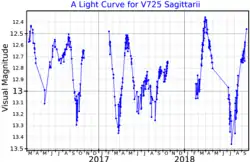| Observation data Epoch J2000.0 Equinox J2000.0 (ICRS) | |
|---|---|
| Constellation | Sagittarius |
| Right ascension | 18h 11m 59.43904s[2] |
| Declination | −36° 06′ 40.3345″[2] |
| Characteristics | |
| Spectral type | K4III (in 2009)[3] |
| Variable type | Unique[4] |
| Astrometry | |
| Proper motion (μ) | RA: −1.111[2] mas/yr Dec.: −4.396[2] mas/yr |
| Parallax (π) | 0.1572 ± 0.0433 mas[2] |
| Distance | approx. 21,000 ly (approx. 6,000 pc) |
| Absolute magnitude (MV) | −2.4[3] |
| Details | |
| Mass | 4.25+0.67 −2.40[5] M☉ |
| Temperature | 4,413[5] K |
| Metallicity [Fe/H] | −0.001[5] dex |
| Other designations | |
| Database references | |
| SIMBAD | data |
V725 Sagittarii is a variable star in the southern constellation of Sagittarius. As recently as a century ago, it was a Population II Cepheid; its transformation was documented by Henrietta Swope beginning in 1937,[7] and is one of the most exciting and instructive events in variable-star astronomy.[8] The star has varied between apparent visual magnitude 12.3 and 14.3.[4]
Prior to 1926, this star showed the appearance of being an irregular variable. It then became a Population II Cepheid showing a regular light curve with a period of 12 days. Monitoring showed a gradual increase to a 21 day period by 1935,[7] but did not show a corresponding change in brightness. The star was mostly ignored until 1967–68 when it was seen to vary by 0.4 magnitude with a 50 day period.[8] Steady observation thereafter showed that the star had experienced a thermal flash and performed a loop on the H-R diagram. It migrated from the asymptotic giant branch (AGB) to the Cepheid instability strip and then back to the AGB.[3]
In 1973, the spectral class of V725 Sagittarii was estimated to be between F8 and G2 and similar to a type Ib supergiant.[3] In 1994 it was observed to be G8 based on the spectral lines of metals and later than F8 based on the hydrogen lines.[9] In 2006, it was reported that in 2000 V725 Sagittarii was an early M star with emission lines.[10] In 2010, the spectral type was estimated from its colours and other properties to be K4III, although possibly late K.[3]
References
- ↑ Percy, John R. (December 2020). "V725 Sagittarii: Unique, Important, Neglected". Journal of the American Association of Variable Star Observers. 48 (2): 162. Bibcode:2020JAVSO..48..162P. Retrieved 6 March 2022.
- 1 2 3 4 5 Brown, A. G. A.; et al. (Gaia collaboration) (August 2018). "Gaia Data Release 2: Summary of the contents and survey properties". Astronomy & Astrophysics. 616. A1. arXiv:1804.09365. Bibcode:2018A&A...616A...1G. doi:10.1051/0004-6361/201833051. Gaia DR2 record for this source at VizieR.
- 1 2 3 4 5 Battinelli, Paolo; Demers, Serge (February 2010). "Multiband Photometry of V725 Sagittarii". Publications of the Astronomical Society of the Pacific. 122 (888): 144. Bibcode:2010PASP..122..144B. doi:10.1086/651069. S2CID 121109034.
- 1 2 Samus, N. N.; et al. (2017). "General Catalogue of Variable Stars". Astronomy Reports. 5.1. 61 (1): 80–88. Bibcode:2017ARep...61...80S. doi:10.1134/S1063772917010085. S2CID 125853869.
- 1 2 3 Anders, F.; et al. (2019). "Photo-astrometric distances, extinctions, and astrophysical parameters for Gaia DR2 stars brighter than G = 18". Astronomy and Astrophysics. 628: A94. arXiv:1904.11302. Bibcode:2019A&A...628A..94A. doi:10.1051/0004-6361/201935765. S2CID 131780028.
- ↑ "V725 Sgr". SIMBAD. Centre de données astronomiques de Strasbourg. Retrieved 2020-12-01.
- 1 2 Swope, Henrietta Hill; Shapley, Harlow (1937). "A peculiar variable with changing period and light curve". Harvard College Observatory Annals. 105 (26): 499–507. Bibcode:1937AnHar.105..499S.
- 1 2 Demers, S. (1973). "The Unique Variable V725 Sagittarii". Journal of the Royal Astronomical Society of Canada. 67: 19. Bibcode:1973JRASC..67...19D.
- ↑ Harris, H. C.; Wallerstein, G. (March 1984). "Kinematics of field type II Cepheid variables". Astronomical Journal. 89: 379–388. Bibcode:1984AJ.....89..379H. doi:10.1086/113524.
- ↑ Percy, John R.; et al. (June 2006). "V725 Sagittarii: From Population II Cepheid to Red Semiregular Variable". The Publications of the Astronomical Society of the Pacific. 118 (844): 805–808. Bibcode:2006PASP..118..805P. doi:10.1086/505183. S2CID 122921279.
